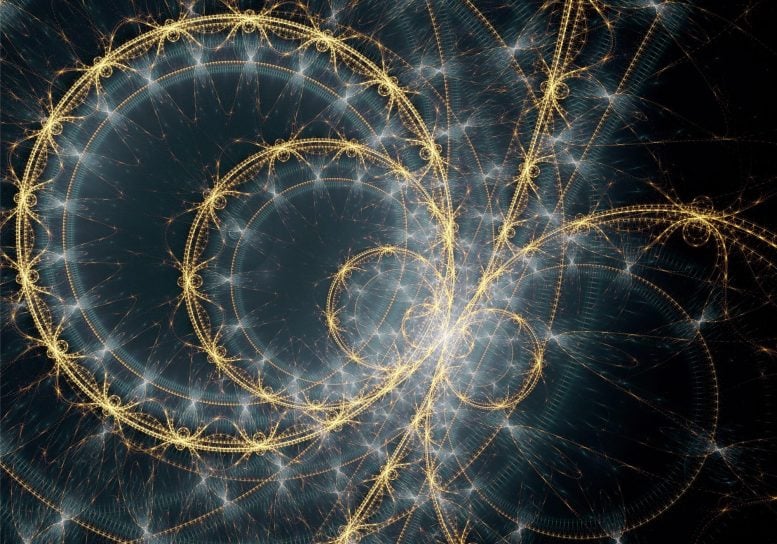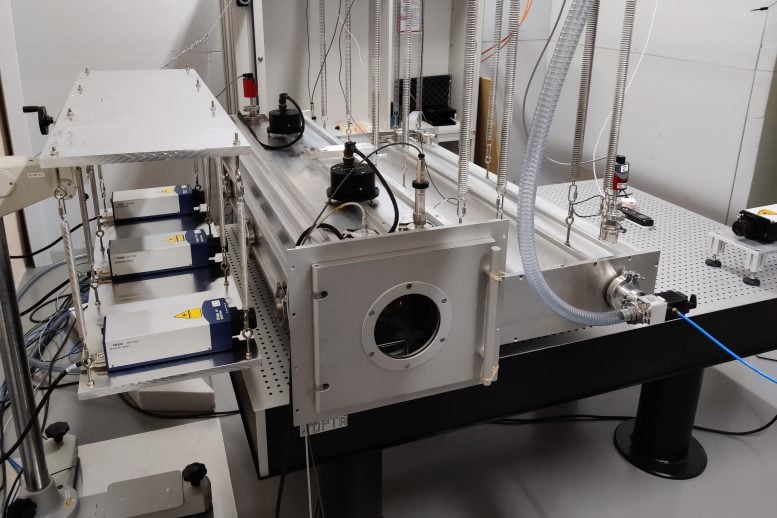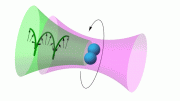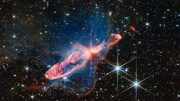
Gravity is a fundamental interaction that causes anything with mass or energy to attract one another.
The Gravitational Constant
The gravitational constant G determines the intensity of gravity, the force that pulls the Earth in its orbit around the sun or causes apples to fall to the ground. It is a component of Isaac Newton’s law of universal gravitation, which was developed almost 300 years ago. The constant must be determined by experimentation since it cannot be mathematically calculated.
The value of G has been the subject of several tests throughout the years, but the scientific community remains unsatisfied with the result. In comparison to the values of all the other important natural constants, such as the speed of light in a vacuum, it is far less accurate.
Gravity is a very weak force that cannot be separated, which makes it incredibly challenging to measure. When you measure the gravity between two bodies, you also have to estimate the impact of all other bodies in the universe.
“The only option for resolving this situation is to measure the gravitational constant with as many different methods as possible,” explains Jürg Dual, a professor in the Department of Mechanical and Process Engineering at ETH Zurich. He and his colleagues conducted a new experiment to redetermine the gravitational constant and have now published their work in the prestigious journal Nature Physics.

With this experimental setup, ETH researchers succeeded in determining the gravitational constant in a new way. Credit: Juerg Dual / IMES / ETH Zurich
A novel experiment in an old fortress
Dual’s team set up their measurement equipment at the former Furggels fortress, which is located close to Pfäfers above Bad Ragaz, Switzerland, in order to exclude sources of interference as much as possible. Two beams hung in vacuum chambers make up the experimental setup. After the researchers set one vibrating, gravitational coupling caused the second beam to also exhibit minimal movement (in the picometer range – i.e., one trillionth of a meter). The researchers used laser equipment to measure the motion of the two beams, and by analyzing this dynamic effect, they were able to estimate the gravitational constant’s magnitude.
The value the researchers arrived at using this method is 2.2 percent higher than the current official value given by the Committee on Data for Science and Technology. However, Dual acknowledges that the new value is subject to a great deal of uncertainty: “To obtain a reliable value, we still need to reduce this uncertainty by a considerable amount. We’re already in the process of taking measurements with a slightly modified experimental setup so that we can determine the constant G with even greater precision.” Initial results are available but haven’t yet been published. Still, Dual confirms that “we’re on the right track.”
The researchers run the experiment remotely from Zurich, which minimizes disruptions from personnel present on site. The team can view the measurement data in real-time whenever they choose.
Insight into the history of the universe
For Dual, the advantage of the new method is that it measures gravity dynamically via the moving beams. “In dynamic measurements, unlike static ones, it doesn’t matter that it’s impossible to isolate the gravitational effect of other bodies,” he says. That’s why he hopes that he and his team can use the experiment to help crack the gravity conundrum. Science has still not fully understood this natural force or the experiments that relate to it.
For example, a better understanding of gravity would allow us to better interpret gravitational wave signals. Such waves were detected for the first time in 2015 at the LIGO observatories in the US. They were the result of two orbiting black holes that had merged at a distance of about 1.3 billion light-years from Earth. Since then, scientists have documented dozens of such events; if they could be traced in detail, they would reveal new insights into the universe and its history.
A career-crowning achievement
Dual began working on methods to measure the gravitational constant in 1991, but at one point had put his work on hold. However, the observation of gravitational waves at LIGO gave it new momentum, and in 2018 he resumed his research. In 2019, the project team set up the laboratory in the Furggels fortress and began new experiments. In addition to the scientists from Dual’s group and a statistics professor, the project also involved infrastructure personnel such as cleanroom specialists, an electrical engineer, and a mechanic. “This experiment couldn’t have come together without years of team effort,” Dual says. He is becoming a professor emeritus at the end of July this year. “A successful experiment is a nice way to end my career,” he says.
Reference: “Dynamic measurement of gravitational coupling between resonating beams in the hertz regime” by Tobias Brack, Bernhard Zybach, Fadoua Balabdaoui, Stephan Kaufmann, Francesco Palmegiano, Jean-Claude Tomasina, Stefan Blunier, Donat Scheiwiller, Jonas Fankhauser and Jürg Dual, 11 July 2022, Nature Physics.
DOI: 10.1038/s41567-022-01642-8








So, I call Bull, “The gravitational constant G must be determined by experimentation since it cannot be mathematically calculated.” I use 4Pi^2/G x M(of the sun) = k, (with nasa define M(of the sun) as 1.988506238 x 10^30 kilograms, k = 2.976507252 x 10^-19, if you use 6.77 x 10^-11 and k = 2.97472331 x 10^-19 if you use 6.674 x 10^-11. the College Physics textbook by Serway and Faughn, has a Useful planetary data table 7.3 on Page 196 and the last column is the constant k, listed as 2.97,2.99,2.97,2.98,2.97,2.99,2.95, 2.99,2.96 for the nine planets mercury to pluto.
Hah – double bull! How do you think they ever derived “M(of the sun)”???
The calculation of gravitational force between two beams vibrating in vaccum forming a couple is too good to give an average relust for universal gravitational constant G.Here the system is so artificial,waits to seek natural background of gravitation.
Gravitation being a natural phenomena,can not produce good result from experimental set up of vibrating beam coupled with another.The system lacks to follow nature.
The result of the experiment for calculation of universal gravitational constant is fair,but due to an isolated system this has small deviation.
I might be wrong but isn’t gravity just the magnetic pull of each body in space like the planets and stars something like to magnets pulling each other and if true I don’t see the big fuss about gravity……sooo someone correct me if I’m wrong….love to learn
Nope. While Magnetism and Gravity are both frequencies. Gravity the implosion result of an exploding frequency. While Magnetism is an induced frequency on a ferritic material. They will tell you that the moon is held in place by the Gravity of the Earth, but when I showed them that the moon is actually held in place by a specific zone created by the frequency generated by the Earth, they all agreed that I was correct. See ESA February 20, 2019.
The dynamic method of vibrating beams coupled togather is able to produce good result for universal gravitational constant G with some error in margin.
With marginal error the dynamical method has good result for determination of G.
With certain erròr the dynamic method approches the value for G.
With certain erròr the dynamic method approches the value for G.ln this experimentation treatments are lacking with some view that is beyond the scope of present physics.
The experimental conditions of the method is often complicated to explain by natural science and are beyond present physics.
Where does the gravity wave go?
The gravitational wave occurs at the highest low frequency. When two black holes try to fit, they orbit each other. Then the surrounding objects move like a wave. Their wavelength is in the millions of kilometers.
Gravity has its limits. That is, distant star gravity and black hole gravity do not affect us. If so, where does the gravitational wave go? That is, at the gravitational limit, the gravitational wave is repeatedly reflected back to the point of origin so that the latency becomes less passive. That is, like a wave of water in a bowl. The gravitational wave will be at low frequency and such wave will not cross the gravitational limit. The discovered gravitational wave has a higher frequency than the cosmic how can it be called a gravitational wave. Even lunar gravity is due to proximity. Gravity is not felt here due to black hole distance. In the gravitational field, only the denser medium carries the gravity, so the gravitational wave is reflected to the center of gravity.
The experimental conditions of the method is often complicated to explain by natural science and are beyond present physics.However,an average result is quite satisfactory.
The anomaly in the result for value of G has no explanation in present physics.However,the
value obtained is a phenomena can be presented by some physics yet to come.But,keeping this unexplained extra value extempted,the result is confirming.Thanks to the authors for accurate result.
I think the best tool for measuring/calculating G maybe LIGO!
LIGO is a super-sensitive device that measures length changes caused by passing gravitational waves!
Realize that G could be measured/calculated by generating our own artificial gravitational waves by periodically moving a test mass w/ known mass (at nearby LIGO) & measuring length changes it creates!
There is no such thing as a gravitational “constant,” gravity is a measurement of inaction, aperiodic gaps of interaction on the quantum scale and entirely system dependent. Granted, in an environment suitable to sustain “intelligent life,” interaction is to the point of being so homogenous that a gravitational constant could be assumed for some cosmically short duration, the true nature of gravity is entirely discreet or quantized, not continuous as suggested by GR. GR is the illusion created from the interior of a clifford torus.
“gravitational coupling caused the second beam to also exhibit minimal movement”, that is called induction resonance or frequency induction. We are all aware that Gravity is the implosion result from expanding frequency, away from source. Radiating waves or radiation waves, from a source, through a medium create a vacuum, this is basic fundamentals of Natural observable phenomenon, laminar flow and hydrodynamics. Explosion, compression and implosion.
The graviton particle just like the magneton particles and other particles are part of what I call the piggy backing principle which are attached stacked etc. and part radioactive particles in their nascent form and a subject to radioactive decay and weaken over time. Hence the constant is a “variable constant ” for all particles and in continuous motion….nothing stationery. Hence the experiment must take into consideration the time decay in the constant a small nano spread. It is very minute. Correct me if I am wrong or test the hypothesis.
David: the masses of the Sun and planets are empirical. You cannot determine them without measurements, and our determination of their masses depends on the value of G. What you are doing is simply recalculating the estimate of G which was used to determine those values initially.
Assuming the universe curvature is >1 and is closed,assuming you go straight in the same direction and returning at the same starting point, all the formulaes are incorrect on astronimic scale. For example the law of gravity between two masses shall to have two terms: a ‘pull’ force calculated using the standard formula and a ‘push’ force calculating as same but assuming D=circumference of universe – d. A consequence of this the force between two corps vanisces when they are at Duniverse/2
Gravity may be weak, but it’s also strong enough to make light travel at a constant speed. We still don’t know how gravitational pulling actually works. We know it’s there, we know that it has a stronger effect the more matter there is, and we are guestimating on what we think the weight of our planet & others are. To find the true strength of gravity, we have to trace everything back to the big bang minimum & then start calculating how fast everything traveled including all collisions & black holes, once we have that information, we have to find the true strength of the gravitational pull of our planet, anything that is at least as big as Earth’s mini moon, the planets in front of us and behind us, plus all the way till Jupiter & the Sun, we also have to take into account how far the gravitational pull truly goes out, after doing that we will finally have an answer to the true constant of Gravity. And that’s IF light doesn’t have an effect on gravity that we don’t know about, anything with them keeping each other in balance & we will know how much our math is truly wrong. Like ALL OF THE MATH we have ever done could be reshaped by the possibility of Gravity keeping light at a constant and vice versa.
Is gravity a force or a distortion of geometry? Einstien said that space is a farbric and what we call gravity is a bending and twisting of that fabric by objects that lay within it. If so then would it require a different mathmatical formula?
Yes, but whose to say that it’s not both a force and distortion. It could just depend on the situation that decides if it’s one of the two, like how light works. So, yes we need all new equations to find the truth.
Gravity can be described as a flow rate. 2.5549…x10^59 m^3/JS^4 = 2πc^3/h = c^3/h-bar =G/lp^2. From this Gravity can be calculated out with the only observation being the fine structure constant. Which I do believe we have a more accurate measurement of.
Everything has to be Relative to something. How can we sit here and assume that our position in the galaxy doesn’t interfere with our observations of it ? Time is Causality, just something we as humans experience the passage of. We have assigned everything arbitrarily, be it Mass, Velocity, distance , everything is anthropomorphic. Shouldn’t the observations be according to Universal and not anthropomorphic measures ? What is the impact of our locality (Earth),Solar system, Perseus arm of the Milky way, on these measurements? Ultimately everything is Relative to something, shouldn’t G be Relative to the spacetime it is being measured in ? If Sagittarius A* has an influence/effect on the Sun,what about its influence on these measurements?